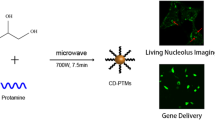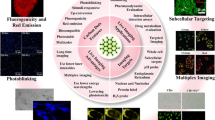Abstract
Carbon dots (CDs) are a rising star in the field of cellular imaging, especially cytoplasmic imaging, attributing to the super-stable optical performance and ultra-low biological toxicity. Nucleolus can accurately reflect the expression state of a cell and is strongly linked to the occurrence and development of many diseases, so exploring bran-new CDs for nucleolus-orientation imaging with no-wash technology has important theoretical value and practical significance. Herein, nitrogen-doped carbon dots (N-CDs) with green fluorescence (the relative fluorescence quantum yield of 24.4%) was fabricated by the hydrothermal treatment of m-phenylenediamine and p-aminobenzoic acid. The N-CDs possess small size, bright green fluorescence, abundant surface functional groups, excellent fluorescence stability and good biocompatibility, facilitating that the N-CDs are an excellent imaging reagent for cellular imaging. N-CDs can particularly bind to RNA in nucleoli to enhance their fluorescence, which ensures that the N-CDs can be used in nucleolus-orientation imaging with high specificity and wash-free technique. This study demonstrates that the N-CDs have a significant feasibility to be used for nucleolus-orientation imaging in biomedical analysis and clinical diagnostic applications.
Graphical abstract









Similar content being viewed by others
References
Wang X, Wang Y, He H, Ma X, Chen Q, Zhang S, Ge B, Wang S, Nau WM, Huang F (2017) Deep-red fluorescent gold nanoclusters for nucleoli staining: real-time monitoring of the nucleolar dynamics in reverse transformation of malignant cells. ACS Appl Mater Interfaces 9(21):17799–17806. https://doi.org/10.1021/acsami.7b04576
Yusupov MM, Yusupova GZ, Baucom A, Lieberman K, Earnest TN, Cate JHD, Noller HF (2001) Crystal structure of the ribosome at 5.5 Å resolution. Science 292:883–896. https://doi.org/10.1126/science.1060089
Hua XW, Bao YW, Wu FG (2018) Fluorescent carbon quantum dots with intrinsic nucleolus-targeting capability for nucleolus imaging and enhanced cytosolic and nuclear drug delivery. ACS Appl Mater Interfaces 10(13):10664–10677. https://doi.org/10.1021/acsami.7b19549
Kelemen PR, Buschmann RJ, Weisz-carrington P (1990) Nucleolar prominence as a diagnostic variable in prostatic carcinoma. Cancer 65:1017–1020. https://doi.org/10.1002/10970142(19900215)65:43.0.CO;2-F
Croissant J, Zink JI (2012) Nanovalve-controlled cargo release activated by plasmonic heating. J Am Chem Soc 134(18):7628–7631. https://doi.org/10.1021/ja301880x
Saini AK, Sharma V, Mathur P, Shaikh MM (2016) The development of fluorescence turn-on probe for Al(III) sensing and live cell nucleus-nucleoli staining. Sci Rep 6:34807. https://doi.org/10.1038/srep34807
Mayank RR, Singh A, Garg N, Kaur N, Singh N (2019) Mitochondria- and nucleolus-targeted copper(i) complexes with pyrazole-linked triphenylphosphine moieties for live cell imaging. Analyst 145(1):83–90. https://doi.org/10.1039/c9an01513b
Liu J, Zhang S, Zhu J, Liu X, Yang G, Zhang X (2019) A triarylboron-based binuclear Zn(II) complex as a two-photon fluorescent probe for simultaneous multicolor imaging of the cell membrane, endoplasmic reticulum, and nucleolus. Anal Bioanal Chem 411(20):5223–5231. https://doi.org/10.1007/s00216-019-01896-x
Zhou B, Liu W, Zhang H, Wu J, Liu S, Xu H, Wang P (2015) Imaging of nucleolar RNA in living cells using a highly photostable deep-red fluorescent probe. Biosens Bioelectron 68:189–196. https://doi.org/10.1016/j.bios.2014.12.055
Shen R, Shen X, Zhang Z, Li Y, Liu S, Liu H (2010) Multifunctional conjugates to prepare nucleolar-targeting CdS quantum dots. J Am Chem Soc 132:8627–8634. https://doi.org/10.1021/ja1002668
Wang X, Wang Y, He H, Chen X, Sun X, Sun Y, Zhou G, Xu H, Huang F (2016) Steering graphene quantum dots in living cells: lighting up the nucleolus. J Mater Chem B 4(4):779–784. https://doi.org/10.1039/c5tb02474a
Gong X, Li Z, Hu Q, Zhou R, Shuang S, Dong C (2017) N,S,P co-doped carbon nanodot fabricated from waste microorganism and its application for label-free recognition of Manganese(VII) and L-ascorbic acid and AND logic gate operation. ACS Appl Mater Interfaces 9 (44): 38761–38772. https://doi.org/10.1021/acsami.7b11170, N,S,P Co-Doped Carbon Nanodot Fabricated from Waste Microorganism and Its Application for Label-Free Recognition of Manganese(VII) andl-Ascorbic Acid and AND Logic Gate Operation
Gong X, Lu W, Paau MC, Hu Q, Wu X, Shuang S, Dong C, Choi MM (2015) Facile synthesis of nitrogen-doped carbon dots for Fe3+ sensing and cellular imaging. Anal Chim Acta 861:74–84. https://doi.org/10.1016/j.aca.2014.12.045
Zheng M, Liu S, Li J, Qu D, Zhao H, Guan X, Hu X, Xie Z, Jing X, Sun Z (2014) Integrating oxaliplatin with highly luminescent carbon dots: an unprecedented theranostic agent for personalized medicine. Adv Mater 26(21):3554–3560. https://doi.org/10.1002/adma.201306192
Gong X, Zhang Q, Gao Y, Shuang S, Choi MM, Dong C (2016) Phosphorus and nitrogen dual-doped hollow carbon dot as a nanocarrier for doxorubicin delivery and biological imaging. ACS Appl Mater Interfaces 8(18):11288–11297. https://doi.org/10.1021/acsami.6b01577
Chen J, Wei JS, Zhang P, Niu XQ, Zhao W, Zhu ZY, Ding H, Xiong HM (2017) Red-emissive carbon dots for fingerprints detection by spray method: coffee ring effect and unquenched fluorescence in drying process. ACS Appl Mater Interfaces 9(22):18429–18433. https://doi.org/10.1021/acsami.7b03917
Shao J, Zhu S, Liu H, Song Y, Tao S, Yang B (2017) Full-color emission polymer carbon dots with quench-resistant solid-state fluorescence. Adv Sci 4(12):1700395. https://doi.org/10.1002/advs.201700395
Su R, Wang D, Liu M, Yan J, Wang JX, Zhan Q, Pu Y, Foster NR, Chen JF (2018) Subgram-scale synthesis of biomass waste-derived fluorescent carbon dots in subcritical water for bioimaging, sensing, and solid-state patterning. ACS Omega 3(10):13211–13218. https://doi.org/10.1021/acsomega.8b01919
Zheng XT, Ananthanarayanan A, Luo KQ, Chen P (2015) Glowing graphene quantum dots and carbon dots: properties, syntheses, and biological applications. Small 11(14):1620–1636. https://doi.org/10.1002/smll.201402648
Baker SN, Baker GA (2010) Luminescent carbon nanodots: emergent nanolights. Angew Chem Int Ed 49(38):6726–6744. https://doi.org/10.1002/anie.200906623
Luo P, Yang F, Yang S-T, Sonkar SK, Yang L, Broglie JJ, Liu Y, Sun Y-P (2014) Carbon-based quantum dots for fluorescence imaging of cells and tissues. RSC Adv 4:10791. https://doi.org/10.1039/c3ra47683a
Borse V, Thakur M, Sengupta S, Srivastava R (2017) N-doped multi-fluorescent carbon dots for ‘turn off-on’ silver-biothiol dual sensing and mammalian cell imaging application. Sensor Actuat B-Chem 248:481–492. https://doi.org/10.1016/j.snb.2017.03.158
Yang W, Zhang H, Lai J, Peng X, Hu Y, Gu W, Ye L (2018) Carbon dots with red-shifted photoluminescence by fluorine doping for optical bio-imaging. Carbon 128:78–85. https://doi.org/10.1016/j.carbon.2017.11.069
Liu H, Yang J, Li Z, Xiao L, Aryee AA, Sun Y, Yang R, Meng H, Qu L, Lin Y, Zhang X (2019) Hydrogen-bond-induced emission of carbon dots for wash-free nucleus imaging. Anal Chem 91(14):9259–9265. https://doi.org/10.1021/acs.analchem.9b02147
Pang W, Jiang P, Ding S, Bao Z, Wang N, Wang H, Qu J, Wang D, Gu B, Wei X (2020) Nucleolus-targeted photodynamic anticancer therapy using renal-clearable carbon dots. Adv Healthc Mater 9(16):e2000607. https://doi.org/10.1002/adhm.202000607
Li H, Ye S, Guo J, Wang H, Yan W, Song J, Qu J (2019) Biocompatible carbon dots with low-saturation-intensity and high-photobleaching-resistance for STED nanoscopy imaging of the nucleolus and tunneling nanotubes in living cells. Nano Res 12(12):3075–3084. https://doi.org/10.1007/s12274-019-2554-x
Li H, Zhang M, Song Y, Wang H, Liu C, Fu Y, Huang H, Liu Y, Kang Z (2018) Multifunctional carbon dot for lifetime thermal sensing, nucleolus imaging and antialgal activity. J Mater Chem B 6(36):5708–5717. https://doi.org/10.1039/c8tb01751d
Zhu Z, Li Q, Li P, Xun X, Zheng L, Ning D, Su M (2019) Surface charge controlled nucleoli selective staining with nanoscale carbon dots. PLoS One 14(5):e0216230. https://doi.org/10.1371/journal.pone.0216230
He H, Wang Z, Cheng T, Liu X, Wang X, Wang J, Ren H, Sun Y, Song Y, Yang J, Xia Y, Wang S, Zhang X, Huang F (2016) Visible and near-infrared dual-emission carbogenic small molecular complex with high RNA selectivity and renal clearance for nucleolus and tumor imaging. ACS Appl Mater Interfaces 8(42):28529–28537. https://doi.org/10.1021/acsami.6b10737
Yin X, Sun Y, Yang R, Qu L, Li Z (2020) RNA-responsive fluorescent carbon dots for fast and wash-free nucleolus imaging. Spectrochim Acta A 237:1183. https://doi.org/10.1016/j.saa.2020.118381
Zhang B, Duan Q, Zhao H, Zhang Y, Li X, Xi Y, Wu Z, Guo L, Li P, Sang S (2021) Application of carbon dots in nucleolus imaging to distinguish cancerous cells from normal cells. Sensor Actuat B-Chem 329(15):129156–129164. https://doi.org/10.1016/j.snb.2020.129156
Kong W, Liu R, Li H, Liu J, Huang H, Liu Y, Kang Z (2014) High-bright fluorescent carbon dots and their application in selective nucleoli staining. J Mater Chem B 2(31):5077–5082. https://doi.org/10.1039/c4tb00579a
Hua XW, Bao YW, Zeng J, Wu FG (2019) Nucleolus-targeted red emissive carbon dots with polarity-sensitive and excitation-independent fluorescence emission: high-resolution cell imaging and in vivo tracking. ACS Appl Mater Interfaces 11(36):32647–32658. https://doi.org/10.1021/acsami.9b09590
Gong X, Lu W, Liu Y, Li Z, Shuang S, Dong C, Choi MMF (2015) Low temperature synthesis of phosphorous and nitrogen co-doped yellow fluorescent carbon dots for sensing and bioimaging. J Mater Chem B 3(33):6813–6819. https://doi.org/10.1039/c5tb00575b
Gong X, Zhang L, Liu Y, Wang H, Cui X, Hu Q, Song S, Shuang S, Dong C (2019) Controllable fabrication, photoluminescence mechanism, and novel application of green–yellow–orange fluorescent carbon-based nanodots. ACS Biomater Sci Eng 5(10):5060–5071. https://doi.org/10.1021/acsbiomaterials.9b01153
Jia Q, Zheng X, Ge J, Liu W, Ren H, Chen S, Wen Y, Zhang H, Wu J, Wang P (2018) Synthesis of carbon dots from Hypocrella bambusae for bimodel fluorescence/photoacoustic imaging-guided synergistic photodynamic/photothermal therapy of cancer. J Colloid Interf Sci 526:302–311. https://doi.org/10.1016/j.jcis.2018.05.005
Li W, Zhang H, Zheng Y, Chen S, Liu Y, Zhuang J, Liu WR, Lei B (2017) Multifunctional carbon dots for highly luminescent orange-emissive cellulose based composite phosphor construction and plant tissue imaging. Nanoscale 9(35):12976–12983. https://doi.org/10.1039/c7nr03217j
Acknowledgments
This work was supported by the National Natural Science Foundation of China (21705101), Shanxi Provincial Key Research and Development Project (201903D121109) and Natural Science Foundation of Shanxi Province (No. 201801D121040 and 201901D211154).
Author information
Authors and Affiliations
Corresponding authors
Ethics declarations
Conflict of interest
The authors declare that they have no competing of interests.
Additional information
Publisher’s note
Springer Nature remains neutral with regard to jurisdictional claims in published maps and institutional affiliations.
This article is part of the Topical Collection on Nanomaterials for biomedical imaging and targeting
Supplementary Information
ESM 1
(DOCX 4981 kb)
Rights and permissions
About this article
Cite this article
Zhang, L., Wang, Z., Wang, H. et al. Nitrogen-doped carbon dots for wash-free imaging of nucleolus orientation. Microchim Acta 188, 183 (2021). https://doi.org/10.1007/s00604-021-04837-7
Received:
Accepted:
Published:
DOI: https://doi.org/10.1007/s00604-021-04837-7




